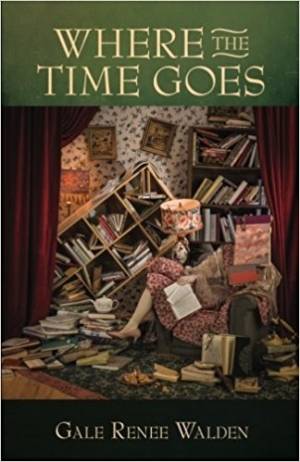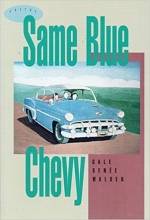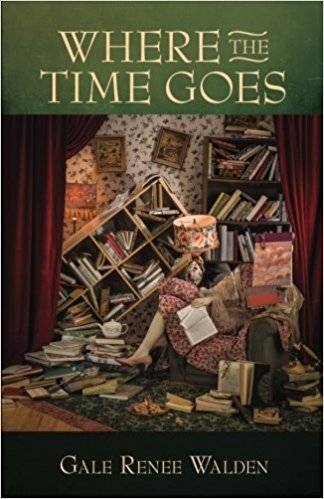I just finished the second book of poetry released by local author Gale Renée Walden, Where the Time Goes, and it wasn’t until I finished that I saw the blurb on the back cover:
“The intelligence and faithfulness to her vision that moves through the poems make even flat landscape voluptuous with meaning.” – American Book Review
If, like me (and probably the majority of our readership), you are a born-fed-bred Midwesterner, or at least have lived here for a good long while*, then perhaps your hackles are also raised. No, not because someone is reading poetry, but because someone somewhere else had to deign to imbue our “flat landscape” with value.
*explicit measurement in Midwestern terms, less than a yonk’s age but longer than apiece.
 The fact that the blurb is most likely about Walden’s first book, Same Blue Chevy, barely redeems it, because that book is even more Illinois than this newest one. In Where the Time Goes, readers are treated to tales of Tucson, AZ, as well as Urbana. Both are technically flat although Tucson is surrounded by mountains; each is beautiful in its own way.
The fact that the blurb is most likely about Walden’s first book, Same Blue Chevy, barely redeems it, because that book is even more Illinois than this newest one. In Where the Time Goes, readers are treated to tales of Tucson, AZ, as well as Urbana. Both are technically flat although Tucson is surrounded by mountains; each is beautiful in its own way.
The fact is, I can’t fault the ABR for its quote – it was clever and earned it a place on a book cover – but for the purposes of Walden’s narratives, it doesn’t matter that the landscape is flat. Or that the Midwest is “boring”. Where the Time Goes is primarily about interior landscapes: people living lives that are beautiful, and someone just happened to observe and record the beauty.
The house where a first memory of music was made could have been in Urbana or upstate New York or Los Angeles, but we would still build the memory alongside her. The conversation about Dead Poets’ Houses could easily have occurred in New England or even abroad. And although “Elegy for Louisette” brings to my mind a very specific neighborhood on Race Street where there used to be a grocery store not too far from a statue of Lincoln – it is not beyond imagining those streets anywhere, even a town of 66,000 in Texas**.
Alright, fine, maybe there is a very specific feel to the Midwestern poems, and a beautiful language and keen expression that illustrates them. To me, these poems are still about people, and to call that landscape flat is shortsighted at best and too insulting to us at worst. So for once, I’ll assume the best.
 Are the people in these poems inherently beautiful? No, I’d assume not, because they are people, and Walden’s descriptions don’t paint false pictures. She doesn’t obscure the dialectic of the woman too long in a relationship. The idea of religion as a grocery store is as stark and unflinching as the fluorescent lights that must illuminate the cashier God. And let’s not talk about the second poem regarding Jonson, because that grief is brutal. But are these people flat? They are not, because they are people.
Are the people in these poems inherently beautiful? No, I’d assume not, because they are people, and Walden’s descriptions don’t paint false pictures. She doesn’t obscure the dialectic of the woman too long in a relationship. The idea of religion as a grocery store is as stark and unflinching as the fluorescent lights that must illuminate the cashier God. And let’s not talk about the second poem regarding Jonson, because that grief is brutal. But are these people flat? They are not, because they are people.
Certainly, there’s beauty in their lives, and although some poems do call forth iconic Midwestern images – such as the front porch with un-brought-in pots on it – it’s very clear to me that the poet is intentionally skirting those Rockwell-esque wholesome tropes of what it means to be corn-fed. Part II ends on a short poem with literal and allegorical corn and hawks and only one word longer than two syllables. Part III begins more wild, switching back to recall some of the Arizona poems already presented, featuring the phrase “javelina eyes, blind and blazing.” Neither of the landscapes nor the people who inhabit them are simple, despite their appearances. I’m glad that a reader found value in these places and people, but for me, the value is in Walden’s telling me what’s out there, and reminding me of what I have.
Walden’s observations are true, a personal truth that will resonate with some readers and bring empathetic understanding to others. Especially the poems of remembered youthful adventures or friendships, the weighted freedom in the speech was evidence of a maturity I look forward to achieving. I haven’t seen it any more than I’ve seen Tucson (which was through the windows of an airport) – but at least I feel like I know something of what it will be like.
Her style is straightforward, choosing words precisely without the need to flaunt, and illustrative: every new story brought a small movie to life inside my mind. I like that her language isn’t “timeless” because all that means is that a poet refuses to observe the culture of a moment. Walden’s language is timely – bringing up Photoshop and facebook and films that are only obscured enough to avoid paying royalties. The poems that happen earlier don’t necessarily code-switch, so you know they were written within reach.
 So, no, I absolutely agree with the praise. I enjoyed reading both Where the Time Goes put out by GusGus Press, and Same Blue Chevy put out by Tia Chucha Press. The latter is available at Jane Addams Book Store, and right now both are available for loan at Urbana Free Library.
So, no, I absolutely agree with the praise. I enjoyed reading both Where the Time Goes put out by GusGus Press, and Same Blue Chevy put out by Tia Chucha Press. The latter is available at Jane Addams Book Store, and right now both are available for loan at Urbana Free Library.








